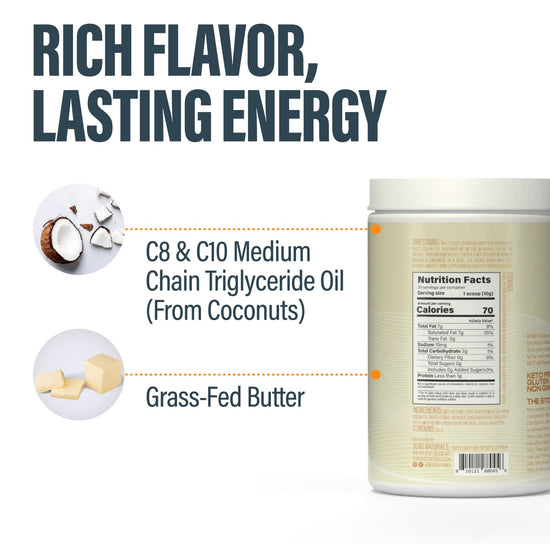Table of Contents
- Understanding Coffee Creamer
- The Shelf Life of Coffee Creamers
- How to Store Coffee Creamer for Maximum Freshness
- Signs of Spoiled Coffee Creamer
- Benefits of Using Fresh Creamer
- Alternatives to Traditional Creamers
- Conclusion
- Frequently Asked Questions
Have you ever taken a sip of your morning coffee, only to be met with an unexpected sour taste? It’s a shocking moment that can turn your caffeine fix into a frustrating experience. Understanding when coffee creamer goes bad is essential for every coffee lover, as it can save you from such unpleasant surprises and ensure that your cup of joe is as delightful as possible.
In a world filled with various coffee creamers—from creamy dairy options to non-dairy alternatives and powdered versions—the question of spoilage becomes increasingly significant. Whether you’re a fan of the classic dairy creamers or prefer the convenience of shelf-stable options, knowing how long each type lasts and how to store them properly can enhance your coffee experience.
In this blog post, we will explore the shelf life of different types of coffee creamers, how to store them for maximum freshness, signs of spoilage, and alternatives to traditional creamers. By the end of this comprehensive guide, you’ll be equipped with the knowledge to keep your coffee creamer fresh and flavorful, ensuring that every sip is satisfying. So let’s dive into the world of coffee creamers and unravel the mystery of when they go bad.
Understanding Coffee Creamer
What Is Coffee Creamer?
Coffee creamer is a popular addition to coffee, designed to enhance its flavor and texture. Typically found in liquid or powdered form, creamers serve as an alternative to milk products like cream or half-and-half. While traditional dairy creamers are made from milk, there are numerous non-dairy options available that cater to various dietary preferences, including vegan and lactose-free lifestyles.
Creamers come in a wide variety of flavors, ranging from classic vanilla to seasonal pumpkin spice, making them a versatile addition to your coffee routine. But as with any perishable product, understanding when and how coffee creamer can spoil is vital for maintaining both flavor and safety.
Types of Coffee Creamers
There are several types of coffee creamers that vary in composition, flavor, and shelf life. Here’s a breakdown:
-
Dairy Creamers: These are made from milk or cream and are typically found in the refrigerated section of your grocery store. They have a shorter shelf life due to their perishable nature.
-
Non-Dairy Creamers: Made from plant-based ingredients such as almond, soy, or oat milk, these creamers are often marketed as suitable for vegans and those with lactose intolerance. They usually have a longer shelf life compared to dairy creamers.
-
Powdered Creamers: These creamers are made from dehydrated milk or non-dairy ingredients and can be stored at room temperature. They are convenient and have the longest shelf life among all types of creamers.
Understanding these differences is essential for properly storing your coffee creamers and knowing when to toss them out.
The Shelf Life of Coffee Creamers
How Long Does Coffee Creamer Last?
The longevity of coffee creamer depends on its type and how it is stored. Here’s a detailed look at the shelf life for each kind:
Dairy Creamers
- Unopened: Typically last for several weeks to a few months when stored in the refrigerator. Always check the best-by date printed on the packaging.
- Opened: Should be consumed within 7-14 days after opening. It’s crucial to keep it refrigerated at all times.
Non-Dairy Creamers
- Unopened: Can last for several months when kept in a cool, dark place. Check the label for specific expiration dates.
- Opened: Should be used within 7-10 days for optimal freshness. Once opened, it should also be refrigerated.
Powdered Creamers
- Unopened: Can last for up to 2 years when stored in a cool, dry place. They are shelf-stable and do not require refrigeration.
- Opened: Should be consumed within a few weeks to a month. Store in an airtight container to keep moisture out.
Mini Creamer Cups
- Unopened: Last around 6-12 months. Once opened, they should typically be consumed within a week.
Factors Affecting Shelf Life
Several factors can influence how long your coffee creamer lasts, including:
- Storage Conditions: Creamers should be kept in a cool, dark place away from direct sunlight and heat to prevent spoilage.
- Packaging: Creamers in airtight containers or sealed packs tend to last longer than those that are not.
- Handling: Frequent opening and closing, as well as exposure to air and contaminants, can reduce the shelf life.
How to Store Coffee Creamer for Maximum Freshness
Proper storage is essential to extend the life of your coffee creamer and maintain its flavor. Here are some tips for storing different types of creamers:
Storing Dairy Creamers
- Keep unopened dairy creamers in the refrigerator, preferably on a middle shelf rather than the door, where temperatures fluctuate more.
- After opening, always seal the container tightly and return it to the fridge immediately after use.
- Avoid letting dairy creamers sit out at room temperature for longer than 2 hours.
Storing Non-Dairy Creamers
- Unopened non-dairy creamers can be stored in a cool, dark pantry.
- Once opened, refrigerate them and use within the recommended time frame.
- Check for any specific storage instructions on the packaging.
Storing Powdered Creamers
- Store powdered creamers in a cool, dry place, away from moisture and humidity.
- Use an airtight container to prevent clumping and to keep out moisture.
- Avoid exposure to direct sunlight, as it can degrade the quality.
Storing Mini Creamer Cups
- Keep mini creamers in a cool, dry place until ready to use. They don’t require refrigeration unless they are opened.
- Once opened, consume them within a week for the best taste.
Signs of Spoiled Coffee Creamer
Knowing how to identify spoiled creamer is crucial for your health and enjoyment. Here are some signs that your coffee creamer has gone bad:
-
Bad Smell: If the creamer emits an unpleasant, sour odor, it is likely spoiled. Fresh creamers should smell sweet and creamy.
-
Sour Taste: If there’s an unexpected sour flavor when you taste the creamer, it’s time to discard it. Always taste a small amount if the smell is off.
-
Chunky Texture: A fresh liquid creamer should have a smooth, pourable consistency. If you notice lumps or curdling, it’s best to throw it out.
-
Clumping in Powdered Creamers: If powdered creamer has clumped together or shows signs of moisture, it may be spoiled.
-
Past Expiration Date: While some creamers may still be safe to consume a short time after the expiration date, it’s always best to err on the side of caution.
Benefits of Using Fresh Creamer
Using fresh coffee creamer not only enhances the flavor of your coffee but also offers several benefits:
- Improved Flavor: Fresh creamers tend to have a richer, creamier taste that elevates your coffee experience.
- Nutritional Value: Fresh dairy creamers provide essential nutrients such as calcium and vitamins, while fresh non-dairy options offer their unique health benefits.
- Maintaining Texture: Fresh creamers provide a smooth, silky texture that enhances the overall drinking experience.
Alternatives to Traditional Creamers
If you find yourself frequently tossing out expired creamers or simply looking for alternatives, there are several options to consider:
- Powdered Creamers: These have a longer shelf life and can add creaminess to your coffee without the risk of spoilage.
- Non-Dairy Milk Options: Almond, soy, oat, and coconut milks provide a creamy texture and are often fortified with vitamins and minerals.
- Natural Sweeteners: Instead of using cream, try sweetening your coffee with honey, agave nectar, or maple syrup for a different flavor experience.
- Milk Frothers: If you enjoy the rich texture of frothed milk, a milk frother can help create that creamy texture using regular milk or non-dairy alternatives.
Conclusion
Understanding when coffee creamer goes bad is essential for maintaining a delightful coffee experience. By knowing the different types of creamers, their shelf life, and proper storage methods, you can avoid unpleasant surprises and enjoy every sip of your coffee. Remember to always check for signs of spoilage, and don’t hesitate to explore alternatives if traditional creamers don’t suit your lifestyle.
Together, we can elevate our coffee rituals, ensuring each cup is not only delicious but also safe to enjoy. So the next time you reach for that bottle of creamer, you’ll be well-informed and ready to savor every moment of your coffee experience.
Frequently Asked Questions
-
How long does unopened coffee creamer last?
- Unopened coffee creamer can last several weeks to months, depending on whether it’s dairy, non-dairy, or powdered. Always refer to the expiration date on the packaging.
-
Can I use coffee creamer after the expiration date?
- It’s not recommended to use coffee creamer after the expiration date, especially if it’s a dairy product. Non-dairy and powdered creamers may still be usable shortly after the date, but check for signs of spoilage first.
-
What happens if I drink expired coffee creamer?
- Drinking expired coffee creamer can lead to mild stomach issues, such as nausea or diarrhea. If you consume a large amount or experience severe symptoms, it’s advisable to see a doctor.
-
How can I tell if my coffee creamer has gone bad?
- Signs of spoilage include a bad smell, sour taste, chunky texture, or clumping in powdered creamers. Always trust your senses when determining freshness.
-
What are some good alternatives to coffee creamer?
- Some popular alternatives include powdered creamers, non-dairy milk options, and natural sweeteners. Each can provide unique flavors and textures to your coffee.
Written by:

Butter MCT Oil Creamer
BUBS Butter MCT Oil Creamer (formerly Halo Creamer): Scientifically-Backed Brain and Body Fuel
BUBS Butter MCT Oil Creamer is your go-to for clean, fast-acting energy and focus, no crash included. It blends creamy grass-fed butter with fast-acting MCT oil powder (C8 and C10) to kickstart your day and keep you sharp. The MCTs go straight to work, giving your brain a quick boost while the grass-fed butter supports digestion and gut health.
Together, they help curb cravings, keep you feeling full longer, and support steady energy throughout the day—perfect for fueling your mornings or powering through the afternoon slump.
Starts at $36.00
Shop

